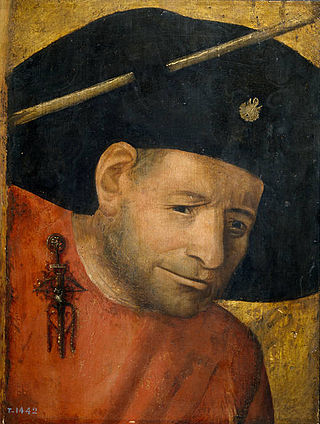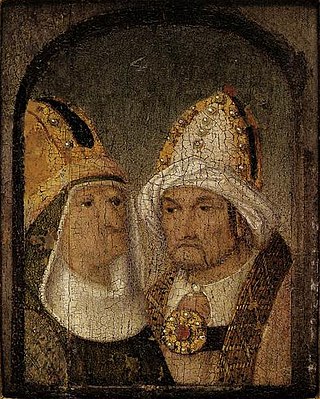
Hieronymus Bosch was a Dutch/Netherlandish painter from Brabant. He is one of the most notable representatives of the Early Netherlandish painting school. His work, generally oil on oak wood, mainly contains fantastic illustrations of religious concepts and narratives. Within his lifetime his work was collected in the Netherlands, Austria, and Spain, and widely copied, especially his macabre and nightmarish depictions of hell.

Ship of Fools is a painting by Hieronymus Bosch, now in the Musée du Louvre, Paris. Camille Benoit donated it in 1918. The Louvre restored it in 2015. The surviving painting is a fragment of a triptych that was cut into several parts. The Ship of Fools was painted on one of the wings of the altarpiece, and is about two-thirds of its original length. The bottom third of the panel belongs to Yale University Art Gallery and is exhibited under the title Allegory of Gluttony. The other wing, which has more or less retained its full length, is the Death and the Miser, now in the National Gallery of Art, Washington, D.C. The two panels together would have represented the two extremes of prodigality and miserliness, condemning and caricaturing both. The Wayfarer(Rotterdam) was painted on the right panel rear of the triptych. The central panel, if it existed, is unknown.

The Garden of Earthly Delights is the modern title given to a triptych oil painting on oak panel painted by the Early Netherlandish master Hieronymus Bosch, between 1490 and 1510, when Bosch was between 40 and 60 years old. It has been housed in the Museo del Prado in Madrid, Spain since 1939.

The Haywain Triptych is a panel painting by Hieronymus Bosch, now in the Museo del Prado, Madrid, Spain. A date of around 1516 has been established by means of dendrochronological research. The central panel, signed "Jheronimus Bosch", measures 135 cm × 200 cm and the wings measure 147 cm × 66 cm. The outside shutters feature a version of Bosch's The Wayfarer.

Cutting the Stone, also called The Extraction of the Stone of Madness or The Cure of Folly, is a painting by Hieronymus Bosch, displayed in the Museo del Prado in Madrid, completed around 1494 or later.
Death and the Miser is a Northern Renaissance painting by Hieronymus Bosch produced between 1490 and 1516 in Northern Europe. The piece was originally part of a triptych, but the center piece is missing. It is a memento mori painting, which is meant to remind the viewer of the inevitability of death and the futility of the pursuit of material wealth, illustrating the sin of greed.

Allegory of Intemperance is an oil on wood painting by Hieronymus Bosch made c. 1490–1500. It is held in the Yale University Art Gallery, in New Haven, Connecticut.

The Wayfarer is an oil on panel painting by Hieronymus Bosch, created c. 1500. It is currently in Museum Boijmans Van Beuningen in Rotterdam. This painting is round and 71.5 cm (28.1 in) in diameter. It is one of the fragments of a partially lost triptych or diptych, which also included the Allegory of Gluttony and Lust, the Ship of Fools and Death and the Miser.

Christ Carrying the Cross is a painting attributed to a follower of Hieronymus Bosch. It was painted in the early 16th century, presumably between 1500 and 1535. The work is housed in the Museum of Fine Arts in Ghent, Belgium. The painting is notable for its use of caricature to provide grotesque-looking faces surrounding Jesus.

Christ Crowned with Thorns, sometimes known as Christ Mocked, is an oil on panel painting by Hieronymus Bosch. It is held in the National Gallery in London, which dates it to around 1510, though some art historians prefer earlier dates.

Christ Crowned with Thorns is an oil on panel painting made in the 1530s by a follower of Hieronymus Bosch. It is now in the Monasterio de San Lorenzo at El Escorial, near Madrid, in Spain.

The Crucifixion of Saint Wilgefortis is a c. 1497 triptych by the Early Netherlandish painter Hieronymus Bosch. The subject of the painting has been uncertain, and it has also been known as the Triptych of the Crucified Martyr, or The Crucifixion of Saint Julia, but is now believed to depict Saint Wilgefortis.

Head of a Halberdier is a fragment of a painting by a follower of Netherlandish artist Hieronymus Bosch. It is currently in the Museo del Prado in Madrid. It is thought to be a cropped piece of a larger painting which might have been damaged.

Two Male Heads is an anonymous painting formerly attributed to Hieronymus Bosch. It is currently in the Museum Boijmans Van Beuningen in Rotterdam.

The Last Judgment is a triptych by Hieronymus Bosch, created after 1482.
The Last Judgment is part of the eschatology of the Abrahamic religions and in the Frashokereti of Zoroastrianism.
Head of a Woman may refer to:

The Fall of the Rebel Angels is an oil-on-panel painting of 1562 by the Netherlandish Renaissance artist, Pieter Bruegel the Elder. The painting is 117cm x 162cm and is now in the Royal Museums of Fine Arts of Belgium in Brussels, Belgium. The Fall of Rebel Angels depicts Lucifer along with the other fallen angels that have been banished from heaven. Angels are falling from the sun in a stacked manner along with ungodly creatures that Bruegel created. This piece by Bruegel was previously thought to be by Hieronymus Bosch. Bruegel was influenced by a variety of artists such as Albrecht Dürer, Frans Floris I, and Hieronymus Bosch. He also got ideas for the creation of his creatures in his previous works.

The Triptych of Temptation of St. Anthony is an oil painting on wood panels by the Early Netherlandish painter Hieronymus Bosch, dating from around 1501. The work portrays the mental and spiritual torments endured by Saint Anthony the Great, one of the most prominent of the Desert Fathers of Egypt in the late 3rd and early 4th centuries. The Temptation of St. Anthony was a popular subject in Medieval and Renaissance art. In common with many of Bosch's works, the triptych contains much fantastic imagery. The painting hangs in the Museu Nacional de Arte Antiga in Lisbon.
















